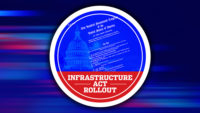
The Obama administration has unveiled a new batch of proposals and initiatives aimed at drawing more private money to invest in U.S. infrastructure, with a particular focus on water projects.
The new plans, announced on Jan. 16, flesh out President Obama’s Build America Investment Initiative, unveiled last July, which seeks to spur additional public-private infrastructure financing ventures.
Vice President Joe Biden, who outlined the plan in a speech at the site of a Washington, D.C., water tunnel project, noted that only 3% of U.S. infrastructure investment comes from the private sector, compared with 30% in Great Britain. He added, “So we’ve got to think of new ways in which to get people in the game.”
A key part of the program is a proposal for new “qualified public infrastructure bonds,” or QPIBs. The White House describes it as similar to private-activity bonds but aimed at public-private partnerships (P3s), to provide such ventures with the benefits of municipal bonds.
Biden said, “We’re going to extend the same advantages to public-private partnerships that exist now [for] projects that are only entirely run by the government.”
Another element of the program is a new Environmental Protection Agency Water Finance Center, which is to work with water agencies and private firms to use federal grants to spark more private financing for drinking-water and wastewater-treatment projects.
In addition, the Agriculture Dept. is setting up a new Rural Opportunity Investment Initiative, which is charged with helping to match private investors with rural water, energy and broadband projects.
Engineering and construction groups welcomed the administration’s latest infrastructure ideas but see them as a supplement to strong, direct federal funds.
Stephen Sandherr, Associated General Contractors of America CEO, said in a statement, “The steps being taken by the administration should make it easier for state and local officials to finance a wide variety of projects designed to upgrade aging clean water systems, improve power transmission networks and keep our roads and bridges safe.”
But Sandherr added that the initiatives won’t solve all U.S. infrastructure needs and said AGC will work for long-term federal infrastructure legislation. The big bill on the horizon is a surface-transportation reauthorization to succeed the current stopgap measure, which expires at the end of May .
Terry O’Sullivan, Laborers’ International Union of North America general president, hailed the administration’s new proposals and programs. But he added that “public-private sector approaches must remain a supplement for public investment, not a substitute.”
O’Sullivan urged Congress to develop and approve a multi-year surface transportation bill and legislation to authorize building the Keystone XL oil pipeline from Canada to Nebraska.
American Society of Civil Engineers President Robert D. Stevens also praised the administration’s programs. He said the new EPA center and Agriculture Dept. initiative “are both strides that will help maximize the benefits from investments to improve our nation’s infrastructure.”
In a summary of the new plan, the White House agreed with Sandherr and O’Sullivan, saying, “Private capital is not a substitute for public investment.”
It also noted that Obama last spring proposed a $$302-billion, four-year surface-transportation bill. But Congress didn’t embrace the proposal, so, the White House said, Obama has been focusing on ways to attract private dollars to roads, bridges and other types of infrastructure.
Fred Kessler, a partner with law firm Nossaman, Los Angeles, pointed to the new infrastructure bond as something that is likely to increase the use of P3s.
Kessler said in an email: “Fully tax-exempt, QPIBs would put private borrowers on the same footing as traditional government purpose bonds.”
He added, “From a public policy perspective it makes a lot of sense. Regardless of who the borrower is, the purpose of the financing is to fund delivery of projects that are government owned and serve the general public.”
The 2005 SAFETEA-LU transportation law made highway and freight-transfer facilities eligible for private-activity bonds, or PABs, but capped the total amount of such bonds at $15 billion.
According to the White House summary, the new QPIBs, if Congress authorizes the program, could also be used for a wider range of projects, including airports, ports, mass transit, solid waste, sewer, water and surface-transportation projects.
The envisioned QPIBs would have no expiration dates, no volume caps and their interest wouldn’t be subject to the alternative minimum tax.
QPIBs would have some limitations—they could not be used for privately owned facilities or privatizing public facilities.
The bonds would require approval from Congress, but the Obama administration can adopt much of the rest of the collection of plans by presidential executive order or administrative actions by individual or multiple federal agencies.
The plans spotlight water infrastructure. Biden said that the new EPA center will not provide “a whole lot of new money.”
He added, “What it is, is the one thing the federal government can do better than any municipal or local or state government—It can find and pull together the best practices in the country and it can make them available to people in other states and communities.”
EPA Administrator Gina McCarthy, who also spoke at the D.C. Water event with Biden, noted that water infrastructure needs are estimated at $600 billion over 20 years. Biden said the new office could attract $6 billion to $28 billion “off the sideline.”
The Agriculture Dept., Biden said, has devoted $10 billion to rural water projects since 2009 and the new office will allow the department agency to “be more proactive” regarding projects in local communities.
The Treasury Dept. and Dept. of Transportation also released a long list of recommendations from a working group convened last year to come up with ways to increase the use of infrastructure P3s.
To address one recommendation—the lack of funding available for planning and other early-stage project work—Obama on Jan. 16 issued an executive order directing DOT and other federal agencies to identify what existing federal grant programs can be used to fund such “pre-development” activities.



Post a comment to this article
Report Abusive Comment